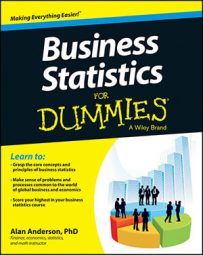A frequency distribution shows the number of elements in a data set that belong to each class. In a relative frequency distribution, the value assigned to each class is the proportion of the total data set that belongs in the class.
For example, suppose that a frequency distribution is based on a sample of 200 supermarkets. It turns out that 50 of these supermarkets charge a price between $8.00 and $8.99 for a pound of coffee. In a relative frequency distribution, the number assigned to this class would be 0.25 (50/200). In other words, that's 25 percent of the total.
Here's a handy formula for calculating the relative frequency of a class:
Class frequency refers to the number of observations in each class; n represents the total number of observations in the entire data set. For the supermarket example, the total number of observations is 200.
The relative frequency may be expressed as a proportion (fraction) of the total or as a percentage of the total. For example, the following table shows the frequency distribution of gas prices at 20 different stations.
| Gas Prices ($/Gallon) | Number of Gas Stations |
|---|---|
| $3.50–$3.74 | 6 |
| $3.75–$3.99 | 4 |
| $4.00–$4.24 | 5 |
| $4.25–$4.49 | 5 |
Based on this information, you can use the relative frequency formula to create the next table, which shows the relative frequency of the prices in each class, as both a fraction and a percentage.
| Gas Prices ($/Gallon) | Number of Gas Stations | Relative Frequency (fraction) |
Relative Frequency (percent) |
|---|---|---|---|
| $3.50–$3.74 | 6 | 6/20 = 0.30 | 30% |
| $3.75–$3.99 | 4 | 4/20 = 0.20 | 20% |
| $4.00–$4.24 | 5 | 5/20 = 0.25 | 25% |
| $4.25–$4.49 | 5 | 5/20 = 0.25 | 25% |
With a sample size of 20 gas stations, the relative frequency of each class equals the actual number of gas stations divided by 20. The result is then expressed as either a fraction or a percentage. For example, you calculate the relative frequency of prices between $3.50 and $3.74 as 6/20 to get 0.30 (30 percent). Similarly, the relative frequency of prices between $3.75 and $3.99 equals 4/20 = 0.20 = 20 percent.
One of the advantages of using a relative frequency distribution is that you can compare data sets that don't necessarily contain an equal number of observations. For example, suppose that a researcher is interested in comparing the distribution of gas prices in New York and Connecticut. Because New York has a much larger population, it also has many more gas stations. The researcher decides to choose 1 percent of the gas stations in New York and 1 percent of the gas stations in Connecticut for the sample. This turns out to be 800 in New York and 200 in Connecticut. The researcher puts together a frequency distribution as shown in the next table.
| Price | New York Gas Stations | Connecticut Gas Stations |
|---|---|---|
| $3.00–$3.49 | 210 | 48 |
| $3.50–$3.99 | 420 | 96 |
| $4.00–$4.49 | 170 | 56 |
Based on this frequency distribution, it's awkward to compare the distribution of prices in the two states. By converting this data into a relative frequency distribution, the comparison is greatly simplified, as seen in the final table.
| Price | New York Gas Stations | Relative Frequency | Connecticut Gas Stations | Relative Frequency |
|---|---|---|---|---|
| $3.00–$3.49 | 210 | 210/800 = 0.2625 | 48 | 48/200 = 0.2400 |
| $3.50–$3.99 | 420 | 420/800 = 0.5250 | 96 | 96/200 = 0.4800 |
| $4.00–$4.49 | 170 | 170/800 = 0.2125 | 56 | 56/200 = 0.2800 |
The results show that the distribution of gas prices in the two states is nearly identical. Roughly 25 percent of the gas stations in each state charge a price between $3.00 and $3.49; about 50 percent charge a price between $3.50 and $3.99; and about 25 percent charge a price between $4.00 and $4.49.

